AMD's DTX Form Factor: Smaller PCs for Everyone?
by Anand Lal Shimpi on October 22, 2007 1:00 AM EST- Posted in
- Cases/Cooling/PSUs
The Reference Platform
Why are we even talking about DTX today? AMD sent us its first DTX reference platform, showing us that actual progress had been made on the standard since its announcement at CES in 2007.
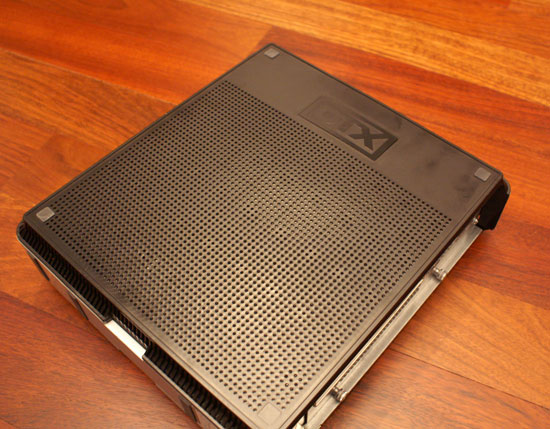
The system uses a reference AMD 690G DTX motherboard, AMD Athlon X2 BE-2350 (45W Athlon 64 X2 running at 2.1GHz), 1GB of DDR2 memory, with a standard 3.5" hard drive, slim form factor DVD drive and a 250W power supply.
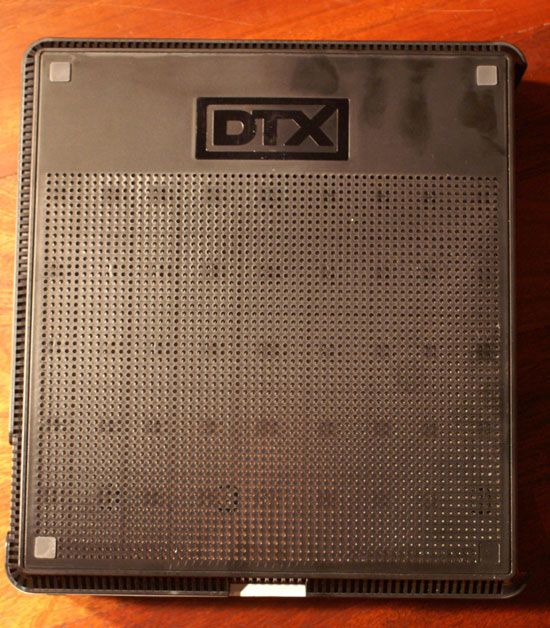


The system itself is quite compact, albeit not particularly stylish. It works and we already know how the Athlon X2 BE-2350 performs so there are no complaints there.
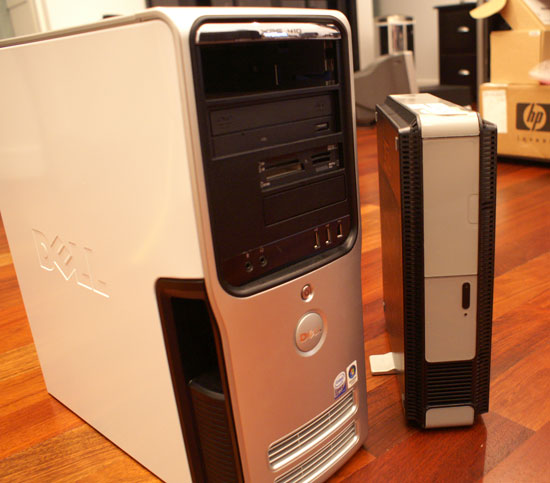
With a power supply fan and CPU fan running, it's reasonably quiet but obviously not silent. AMD mentioned that the prototype chassis we received was missing a vent over the power supply and thus would be louder than normal. We noticed that during usage the fans spun up to a level too high for use in a quiet HTPC environment. AMD cautioned us against drawing any conclusions based on this prototype's performance, and we tend to agree (although that does mean that the reference design is good for little more than some nice pictures).
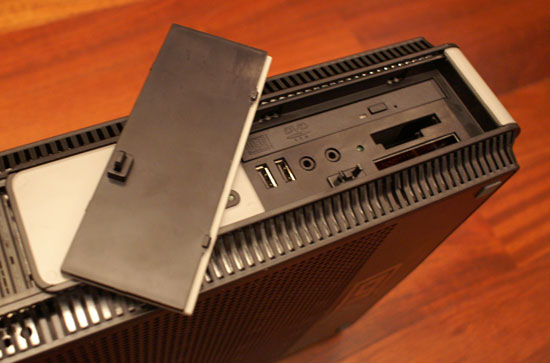
The removable flap covers the DVD drive, but isn't hinged, it just comes off...thankfully this is a prototype
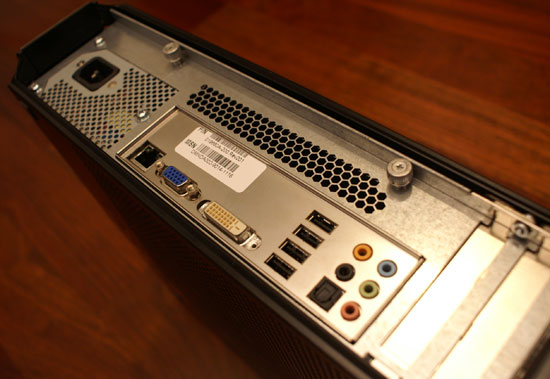
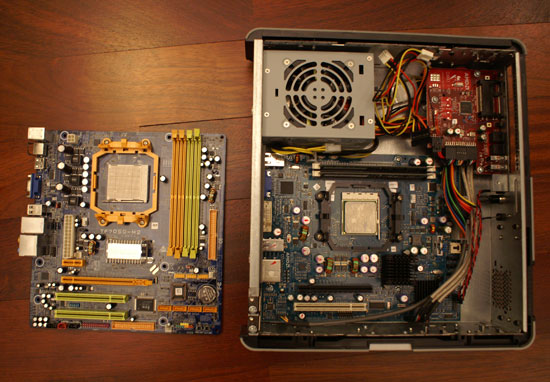
A micro ATX motherboard (left) vs. DTX platform (right)
Obviously the performance of the reference design doesn't really matter in the grand scheme of things, it's really a question of how well the designs that hit the market in the future fare.










37 Comments
View All Comments
geok1ng - Wednesday, July 23, 2008 - link
there is a problem to be solved and it is actually FIND small cases!a- The idea behind BTX is to gain a few inches over the microATX desing to put the PSU and the optical drive together. The idea works quite well.
b- but small cases are hard to find
c- small AND reliable PSUs are harder still!
without cheap cases orcheap and reliable PSUs it is no use to have a $70 CPU over a $70 motherboard, even if the setup can play blurays on the fly (AKA 780G chipset)
BeowulfX - Friday, October 26, 2007 - link
I think they should just stop meddling with the form factor (whether it’s Intel or AMD), IMHO, because PC users have managed to survive with the current ATX or m-ATX form factors.There ain’t much PC users out there who like the idea of throwing their expensive yet still useful mid/full-tower ATX cases (branded or modded) and working ATX/m-ATX motherboards into the attic just so they could have a slimmer casing…as if the constant CPU upgrades isn’t enough yet to cause people to keep spending…
If there were really a lot of people who approve of changing current form-factors for motherboards and PC casing…then why is BTX not so popular?…don’t tell me its all about implementation…because I think it’s MORE about people support and practicality (i.e. using hard-earned money to just buy some other useful PC stuff than throw away functioning current ATX mobos and PC cases for BTX or this proposed DTX form-factor).
On the other hand, this DTX form-factor might simplify things up a bit (generally speaking, that is), yet in this particular case or situation, I’m more inclined to follow the old adage: “don’t fix it if it ain’t broke”.
This will probably gain limited acceptance in some big-time offices and for some PC users who don’t have much room space to spare for a full ATX tower or even for wealthy PC users looking for some other ways to spend their overflowing filthy rich treasure boxes…but personally, I think companies like AMD or Intel should just focus their efforts more in persuading software outfits to create apps that’ll put dual-cores, quad-cores to good use (and I mean creating more and more 64-bit/multithreaded apps).
Leave the form factor alone…encourage first software support for 64-bit/multithreaded apps (i.e. AMD is already contemplating on doing this by their Light Weight Profiling “LWP” proposal)…then may be, after we see abundance of softwares for our hardwares, Intel or AMD can go back on harassing us to give up our modded/expensive/branded full-ATX or mid-ATX PC cases and accompanying ATX motherboards.
hans007 - Tuesday, October 23, 2007 - link
if you didnt notice the latest dimensions and vostro machines are micro ATX again.almost all the big box machines except the enthusiast platforms are microa ATX anyway. look at hp, all their Q6600 machines even are micro ATX for the pavilion line.
the further miniturization by DTX is pretty stupid. why bother with mini DTX when the very similar mini-itx is there. and why bother with DTX when flex ATX is there (flex ATX has 2 slots for everyone who wants DTX for having 2 slots).
DTX is still just as "deep" as microATX (it goes out to the 3rd row of screw holes on microATX) so that is moot. there are plenty of microATX boards that b arely go past the 2nd row of screw holes (so only 8" or so)... even fairly new boards based on G31 etc.
so yeah DTX is not really that awesome since well we have flexATX and mini ITX already. AMD is tring to just make up a new "standard" even though the market doesnt really need it. and BTX is dead, i would not be surprised if the next generation of dell optiplex is also just plain ATX also , since new cpus are fairly low power, and heatpipe coolers are just as quiet now anyway (some HP pentium D machinse used AVC heatpipe coolers which were just as quiet as btx)
sprockkets - Tuesday, October 23, 2007 - link
Don't forget about how it makes it also easy to manufacture, i.e. make 4 boards from a motherboard set.shecknoscopy - Monday, October 22, 2007 - link
If this announcement were made, say, two years ago, then AMD's major selling point for the platform would be its expandability within a small-form factor setup. But the days of its true principle competitor - mini-ITX - being limited to embedded VIA CPUs and PCI expansion are long over. Since both AM2 and LGA775-based mITX board with pretty much any kind of exapnsion options (PCIe x16, onboard SATA-raid, etc...) are available to- or soon to be available to- the public, and since such boards have both a smaller footprint and lower thermal consumption, I honestly don't see the point to DTX. And yes, mITX can be mounted on ATX-specification holes. Or inside a pumpkin.*My guess is that this might be more of a move meant to advance the AMD brand rather than AMD's technologies. Namely, their image as a company which refuses to be pidgeon-holed within the confines of the status quo is only aided by their purported creation of a new small form-factor spec. And for the non ITX enthusiasts, maybe this seems like news - one might believe that this is AMD further pushing development in a field that's been under-explored by their competitors. But it's just not the case, really.
-Sheq (good to be back!)
*-Hey, 'tis the season.
sprockkets - Tuesday, October 23, 2007 - link
Don't mind Intel or AMD based ITX boards, just the fact that the stupid heat sink takes up all the room, requires laptop ram, and the stupid board has to cost $250 or more without a CPU.bupkus - Tuesday, October 23, 2007 - link
Introducing Intel's "Little Valley" mini-itx for < $80http://www.newegg.com/Product/Product.aspx?Item=N8...">Link
Bluestealth - Tuesday, October 23, 2007 - link
It kinda sucks that you have to be an OEM to bring costs for ITX systems down, but it goes with the territory I guess.Although I have to say, even the completed ITX systems/terminals the OEMs sell are quite overpriced :)
flipmode - Monday, October 22, 2007 - link
Dunno, but this is one of the most exciting developments in the home PC arena right now in my opinion. I'm quite looking forward to seeing these products hit retail and get reviewed.I never really read up on BTX but my understanding of that form factor was that it's sole purpose was to enhance cooling. I heard that it required expensive retooling of manufacturing facilities, and that AMD's platform had issues with the component arrangement.
Contrast that with DTX: it's compatible with ATX so minimal retooling and it's purpose is to introduce and industry standard small form factor. That doesn't sound very similar to BTX.
I've got a BTX base Dell Optiplex small form factor desktop here at work and I love it - it's small, it's quiet, it runs extremely cool, and with a DVD-RW, C2D6600, 4GB, 160Gig, and Radeon x1300 it is a very powerful machine.
So if DTX make a machine like that available to the DIY crowd then I'll be pretty dang excited.
I'd say the number one force of resistance to DTX will be graphics technology where the components are getting larger at a crazy rate. We went from single slot cards to double slot cards to dual double slot cards and evidently next it'll be quad double slot cards.
But for the rest of us non gamers DTX will be an answered prayer. All I want is a stand alone video card but it doesn't have to be powerful, just up to snuff on features.
Meh, just thinking out loud.
Martimus - Monday, October 22, 2007 - link
With the size of LCD monitors, and the size of these motherboards, we could start seeing computers where the Monitor, CPU, and Drives are all one unit like they were years ago. This would be nice, because it would make them more mobile, and would tkake up less space. It would make it more difficult to make adjustments to the components, but most people don't really tinker inside their computer anyway. I would like to see some computers like that (Other than my 1980 Compaq with a 10MB hard drive, or the old Apple computers what had everything integrated into the monitor).